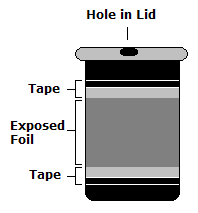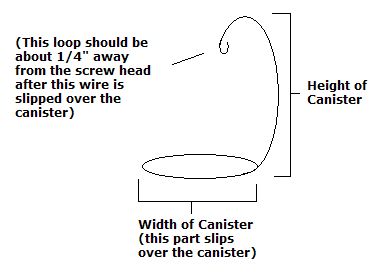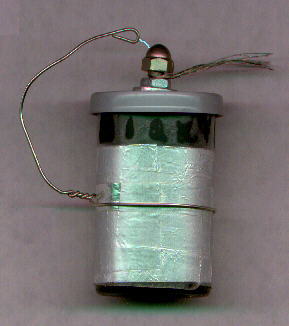Making a Film Canister Leyden Jar
Make some sparks using a film canister and other household objects.This tutorial was originally published on Forever Geek on April 7, 2005.
I wrote these plans after building building the project pictured at sparkbangbuzz.com. I drew all of the pictures (excluding the photograph) using MS Paint.
This is a guide on how to make a Leyden Jar that makes awesome blue sparks with materials mostly just lying around your house. It’s cheap, it’s basically harmless, and it’s fun! First, here’s a list of the materials you will need:
- An empty film canister with its lid
- Multistrand insulated wire
- Single conductor/solid uninsulated wire, about 1.5mm in diameter
- Some aluminum or copper foil (NOTE: Any conductive foil will work. Copper foil is thicker and easier to work with than aluminum foil, but aluminum foil works if that’s all you have.)
- A screw with a round head that is shorter than the film canister’s height
- Two nuts that fit on the screw
- Scotch tape
- NOTE: The next two items are optional.
- A PVC Pipe, 3/4" wide and about 3 or 4 feet long.
- Fur, wool, or cotton fabric
Now that you have all of the parts, let’s get to work. First, drill (or poke) a hole in the center of the lid of the film canister. The hole should be just wide enough to allow the screw to fit snugly inside it. Next, cut a rectangle of foil large enough to wrap around the outside of the canister, and about 2/3 of the height of the canister. Tape the foil to the canister, being sure to leave an “open section” for a loop of wire to go around the canister over the foil (you should just need to tape the foils’ edges to the outside of the canister.) This is roughly what your canister should look like with the top on (sorry for the horrible MS Paint art.)

Make another piece of foil the same size as the first piece, and fasten it inside the canister. If you’re using heavy foil, you shouldn’t need to use tape; the tension of the foil being rolled up should be enough to keep it plastered to the inside of the canister. If you are using lighter foil, you’ll need to tape the edges of the foil to the inside of the canister in a similar fashion. It is very important that the foil touches the container all the way around the inside of the canister.
Now, it gets a little more complicated. Secure the multistrand wire to the top of the lid using the screw and a nut (see image below.) The multistrand wire should be about 1" or 2 cm long, and should have about 1/4" or .75 cm of insulation stripped off both ends. Make a hook on one end of the wire, and secure it in between a nut and the outside of the lid. Fan/spread out the conductors on the other end of the wire. Secure the solid wire to the bottom of the film canister in a similar fashion. Bend the wire as shown below, making it poke out wider than the canister lid. This way, the wire is guaranteed to touch the foil on the inside of the film canister when the lid is put on. Make a loop at the end of the wire so that it won’t tear through the foil on the inside of the canister and to make better a electrical contact. If this is confusing, look at the drawing below (again, sorry about MS Paint.)

Place the lid on the container, ensuring that the wire loop touches the foil on the inside. If the loop doesn’t touch the foil on the inside, bend the loop farther outwards until it does.

Last, bend another piece of wire into the shape above, and insert it over the bottom of the canister onto the ‘open section’ of foil, so that it looks similar to the finished Leyden Jar below. Make sure the top of the wire is at a MAXIMUM of 1/4 of an inch away from the screw head. After the wire is in the corect position, cover the outside of the canister with scotch or electrical tape so that you don’t shock yourself while handling it (the canister below is covered with scotch tape, although it’s kind of hard to see.)

Image from sparkbangbuzz.com
You’re done! You have just built something called a Leyden Jar–in effect, it’s a very simple capacitor. To use it, simply wave the canister over the surface of a CRT TV screen or monitor, or anything that makes static electricity (the multistrand wire ‘receives’ the static electricity and should therefore be closest to the static source.) Then gently push down the solid wire on the outside so it reaches a little closer to the screw head (without touching) and ZAP! There’s your spark. Most of the time, the Jar will discharge itself with no extra help. If you’re having trouble charging the Jar, you can use the last two materials on the material list to build a simple but excellent static generator. Take the fabric and rub it along the pipe all the way up, then all the way down. Have someone else hold the Leyden jar; pressing the multistrand pickup wires to the pipe, and discharge the Jar after a few seconds of rubbing.
Please note that the finished Leyden Jar holds high voltage, low current electricity, which is normally harmless. However, don’t take any chances! If you’re not sure if it’s charged or not and you think it’s not safe, simply press the press on the outside wire against the screw to completely discharge it. Keep your finger away from the screw head area as much as possible while it’s charged. You don’t want an ‘accident’ (you’ll just get a static shock. No one likes getting a static shock.)
I would like to give special thanks to Lenny R. of sparkbangbuzz.com for his ideas. As far as I know, the original “Film Can Leyden Jar” was his design.
That being said, happy spark making!
 This work is licensed under a Creative Commons Attribution-NonCommercial-ShareAlike 3.0 Unported License.
This work is licensed under a Creative Commons Attribution-NonCommercial-ShareAlike 3.0 Unported License.
 Josh Dick
Josh Dick